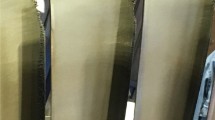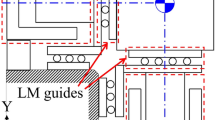Abstract
We propose a spiral-groove aerodynamic thrust bearing functioning as a viscous vacuum pump in a laser scanner motor to reduce the windage power loss of a polygon mirror. The proposed bearing pumps out the air in the scanner housing using the pumping effect of the spiral-groove thrust bearing, reducing the inner pressure of the housing. The pumping performances and the static characteristics of the spiral-groove thrust bearings were investigated numerically and experimentally. Two numerical calculation methods were used to study the pumping characteristics of the spiral-groove thrust bearing. It was found that a bearing with 15 spiral grooves reduced the inner pressure of the housing to <0.01 MPa at 20,000 rpm and at bearing clearance of 2.5 μm, and this has sufficient load-carrying capacity to support the rotating shaft and the mirror.













Similar content being viewed by others
Abbreviations
- D :
-
shaft diameter
- e :
-
rotor displacement in the axial direction from the center position
- G m :
-
mass of air in the sealed housing
- h :
-
bearing clearance
- h d :
-
groove depth
- h r0 :
-
average bearing clearance in the ridge region
- h g0 = h r0 + h d :
-
average bearing clearance in the groove region
- h g and h r :
-
bearing clearances at the groove and ridge regions, respectively
- H 0 = h g0 /h r0 :
-
the ratio of the bearing clearances
- l w :
-
length of land region
- n :
-
number of grooves
- p :
-
pressure
- p a :
-
ambient pressure
- p i :
-
pressure in the sealed housing
- P i = p i /p a :
-
dimensionless pressure in the sealed housing
- P u :
-
ultimate pressure
- q :
-
mass flow rate in the bearing clearance
- r 0 :
-
shaft radius
- t :
-
time
- V i :
-
inner volume of the sealed housing
- r and θ :
-
radial and circumferential coordinates, respectively
- α :
-
ratio of the groove width to the (ridge + groove) width
- β :
-
groove angle
- ε = e/h r0 :
-
dimensionless axial displacement of the rotor
- λ = paλa/p :
-
molecular mean free path
- λa :
-
molecular mean free path at atmospheric pressure (= 0.064 μm)
- \( \Lambda = 6\mu \omega r^{2}_{0} /p_{a} h^{2}_{{r0}} \) :
-
bearing number
- μ :
-
viscosity of air
- ρ :
-
density of air
- ω :
-
rotational angular velocity
- ξ and η :
-
boundary-fitted coordinates
- r :
-
ridge region
- g :
-
groove region
References
Burgdorfer A (1959) The influence of the molecular mean free path on the performance of hydrodynamic gas lubricated bearings. Trans ASME J Basic Eng 81(1):94–100
James DD, Potter AF (1967) Numerical analysis of the gas-lubricated spiral-groove thrust bearing-compressor. Trans ASME J Lub Tech 89(4):439–444
Kawabata N (1986) A study on the numerical analysis of fluid film lubrication by the boundary-fitted coordinates system (first report, fundamental equations of df method and the case of incompressible lubrication). Trans JSME Ser C 53(494):2155–2160
Sato Y, Ono K, Iwama A (1990) The optimum groove geometry for spiral groove viscous pumps. Trans ASME J Trib 112(2):409–414
Sato Y, Knight JD (1992) Performance characteristics of shrouded rayleigh-step and spiral groove viscous pumps. Trans ASME J Trib 114(3):499–506
Tanaka K, Muraki H (1991) Performance of air-lubricated hydrodynamic bearing spindles for laser scanners. Trans ASME J Trib 113(3):609–614
Vohr JH, Chow CY (1965) Characteristics of herringbone-grooved gas journal bearings. Trans ASME Ser D 87(3):568–578
Whipple RTP (1958) “The inclined groove bearing”, AERE Report T/T 622 (revised), United Kingdom atomic energy authority, research group, Atomic energy establishment, Harwell, Berkshire
Yoshimoto S, Takahashi A (1999) A method of reducing windage power loss in a laser scanner mirror by using the pumping effect of herringbone-grooved gas journal bearings. Trans ASME J Trib 121(3):506–509
Yoshimoto S, Ito Y, Takahashi A (2000) Pumping characteristics of a herringbone-grooved journal bearing functioning as a viscous vacuum pump. Trans ASME J Trib 122(1):131–136
Malanoski SB, Pan CHT (1965) The static and dynamic characteristics of the spiral-grooved thrust bearing. Trans ASME J Basic Eng 87:547–558
Author information
Authors and Affiliations
Corresponding author
Rights and permissions
About this article
Cite this article
Yoshimoto, S., Miyatake, M., Iwasa, T. et al. A method of reducing the windage power loss in a laser scanner motor using spiral-groove aerodynamic thrust bearings functioning as a viscous vacuum pump. Microsyst Technol 13, 1123–1130 (2007). https://doi.org/10.1007/s00542-006-0327-4
Received:
Accepted:
Published:
Issue Date:
DOI: https://doi.org/10.1007/s00542-006-0327-4




